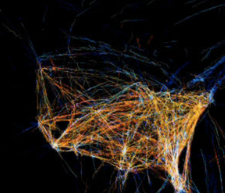Together with co-authors Kim Halskov and Rune Nielsen, I have recently had the paper Maps for design reflection accepted for the journal Artifact. I will make a version of the paper available here as soon as it is officially published.
This paper introduces, applies, and discusses a set of design artefacts called maps for design reflection, intended to support design researchers in capturing, analysing, and reflecting upon design processes. The maps focus on reflection with respect to the role of sources of inspiration and design materials in the emergence and transformation of design ideas. The paper revolves around a specific case, the design of media façades – i.e. displays that are an integrated part of a building’s façade – as part of the development of material for a bid in an architectural competition for a new modern art museum in Warsaw, Poland.
We present and discuss three types of maps, namely overview maps, strand maps, and focal maps. They differ in scope as well as application: overview maps outline the entire design process and are intended for reflection upon the general trends and developments in the project, particularly with regards to the numerous concepts and materials brought into play; strand maps trace a specific design concept through its life-cycle in the design process and are intended primarily for reflection upon the transformations the concept undergoes and the various ways in which it is represented; finally, focal maps capture specific design moves and experiments and are intended for guided description of and reflection upon relevance, rationale and insights tied to these experiments.
Dalsgaard, P., Halskov, K., Nielsen, R. 2009, “Maps for design reflection”, accepted for publication in Artifact, Routledge.
